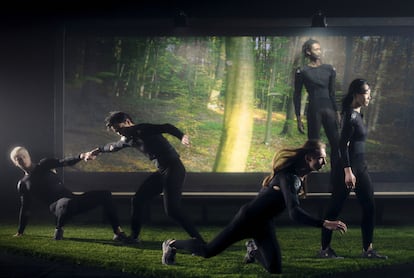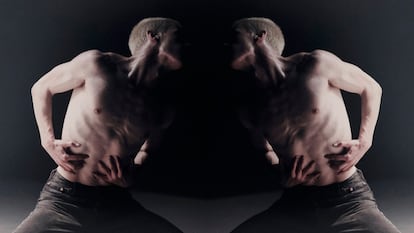'Simulacro', a video game with a scenario featuring open tombs

A type of opinion piece that describes, praises, or criticizes, in whole or in part, a cultural or entertainment work. It should always be written by an expert in the field.

In just over a month, on July 29th, Kor'sia's new show, titled Simulacro, which had its world premiere this Friday at the Conde Duque, will have its international debut at the Teatro Piccolo Arsenale as part of the 2025 Venice Biennale dance program, personally chosen by its artistic director, Wayne McGregor. Before that, on July 17th, at the Opéra Garnier in Monte Carlo, Mattia Russo and Alejandro de Rosa will premiere, with the team of dancers from the Principality of Monaco's company, a creative work: Bronia , inspired by Bronislava Nijinska and commissioned by Jean-Christophe Maillot, director of the Ballets de Monte Carlo. A feverish and intense activity that forces them to push themselves in both creative and formal aspects. Russo and De Rosa are already front and center, with a next stop in Gothenburg in October (where they are being billed as: "acclaimed Spanish duo recognized for their visionary creations"). Does it matter that they are southern Italians (the former from Atripalda Avelino and the latter from Castellammare di Stabia) and graduates of the Accademia del Teatro alla Scala in Milan? Not at all! We are from where we are allowed to grow, said Lucretius, someone who was maliciously ignored by his contemporaries, practically to the point of being hidden.
Sometimes, dance performances awaken poets. When Ann Carson saw The Great Tamer, she wrote a long poem and sent it to the choreographer Dimitris Papaioannou; there began an exchange between poets (hence the title of this essay). Kor'sia could inspire that kind of passion and elevated dialogue beyond pedestrian recession; one can assimilate or savor them from their poetics, because they possess it and defend it even within a figurative video game and endlessly spinning around a roundabout. In Kor'sia, they think and then exist choreographically. A Cogito, ergo sum deconstructed with viciousness and refreshing malice. There's no fuss or waste of time. We have many examples of simulation, in aesthetics, with which we could compare this superb overall work, with its captivating current aesthetic. If there's an insistence on the poetic and its accident, it's because it's effective as a substitute for any linear narrative. In Simulacro, almost nothing is told; Seven young people wander around a supposedly unique stimulus. The gratuitously strident sound does its own thing (it doesn't always accomplish its mission, although in the final 15 minutes, it gets a reprieve). Lights are almost always a dangerous enemy these days, and here the spotlight lives up to the old saying "me against the world."
It's always good when choreography inspires enjoyment and thought! We shouldn't be vindictive; that's corny; we should position ourselves with pure, unadulterated quality. Cunningham said that talking about dance was like nailing gelatin to a wall: a vain act. I don't believe that in the case of Kor'sia, who strives to foster its formwork so that the bridge is solid and can be jumped over. We are also our words, whether poem or simulation. Applying critical deconstruction to choreography—where it cannot be denied there is still a post-structuralist scent—deserves careful analysis and full attention. These seven magnificent artists neither come nor go; they are in their own loop of simulation; they court each other, challenge each other, argue, and absorb themselves in the night. The billboard perched on the grass of the roundabout doesn't have a commercial, but a fourth dimension that is traversed, and is both nourished and destroyed. The quartz spotlights, in their robust hardness, remind us that there were better times. Deterioration is not visible; it is felt.
Baudrillard's Culture and Simulation has done almost as much damage as the Bible; it chokes like a rotten croissant. It probably had its best-selling moment, burning its own and others' bridges, propelling those already driven by cold philosophy. Several choreographers have embraced it as their cryptic recipe book (there is a definitive and specific essay on Baudrillard and avant-garde choreography published by Thomas Heyd in 2000: Art of Body Among Simulacra ), and the almost always pedantic, preachy performance theorists cite it with religious devotion. Does Baudrillard need Kor'sia? It's debatable, just as Forsythe turned to Laban or Libeskind, as Baudouin and Gilpin noted in their day (their proposals around choreutic deconstruction and the computerized or virtual simulation of the dancer, their dance, are fiercely relevant more than 30 years after they were first enunciated).

When Forsythe premiered Six Counter Points at the Frankfurt Opera in 1996 (there's something here in Conde Duque that vividly reminds me of that complex evening, and it's not steps or phrasing, but intentions), Baudrillard was already expressly cited, accompanied by Derrida, Virilio, and even a hint of Deleuze. Already at that time, Roland Barthes also appeared as a crutch and garnish for the most advanced creators. Simulation has been present in ballet since before Romanticism, and in Coppélia it had a ceiling. Simulation by artifact or by conviction. This was said by Élisabeth Roudinesco, who has written very important things about simulacrum and simulation, and her sharp criteria—or interpretive paths—are helpful, and it's pertinent to quote her if we're dealing with a highly intellectualized choreographic product like Simulacro de Kor'sia. It's one option, among others, to frame the product. There is no shortage of dancing, but it is recurrent, it is cornered to give prominence to the group.
It could be hypothesized that this creative group had a stable dance group to work with. This is a necessity of the productive mechanics of choreography. Kor'sia has no artistic headquarters; her home is an email and a website, and these two artists build to the rhythm of the seasons and the tastes of the programmers. It's a heroic struggle, and that determines the product. Developing a style requires stability, resources, and a system. They're doing quite well, although not everyone agrees and a sector of Spanish contemporary dance itself sees them as a potential enemy, like emulators of Lucretius. One fails to see much tenderness in the asphalt of the roundabout, and the complicity is roughly calculated to remain anxiously informal, like gelatin. Dancing bodies can be essentially gelatin, not gelatinous.
Company: Kor'sia.
Choreography: Mattia Russo and Antonio De Rosa
Music: Alejandro da Rocha (with sound design and video by Nousecous)
Set design: Amber Vandenhoeck
Lights: Flickers
Costume design: Luca Guarini
Dramaturgy: Agnès López-Río.
Conde Duque Center, Madrid. June 20. Performances until Sunday, June 22.
EL PAÍS

%3Aformat(jpg)%3Aquality(99)%3Awatermark(f.elconfidencial.com%2Ffile%2Fbae%2Feea%2Ffde%2Fbaeeeafde1b3229287b0c008f7602058.png%2C0%2C275%2C1)%2Ff.elconfidencial.com%2Foriginal%2F34a%2Feab%2F1c9%2F34aeab1c92db90e9a44ce1032a80013d.jpg&w=3840&q=100)


